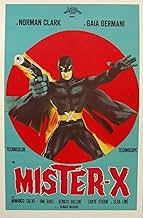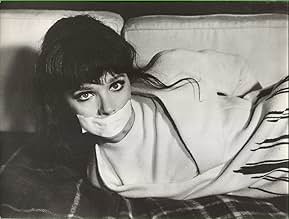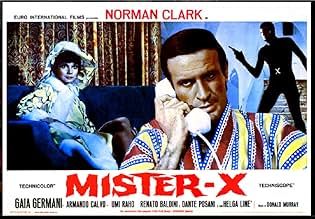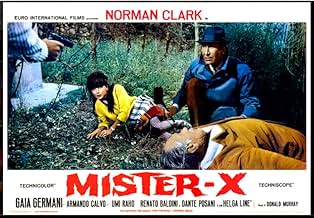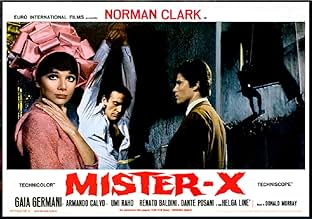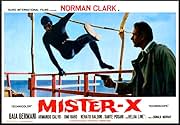A retired ex-criminal, the notorious Mister X, must clear his name when an up-and-comer commits a heinous copycat crime.A retired ex-criminal, the notorious Mister X, must clear his name when an up-and-comer commits a heinous copycat crime.A retired ex-criminal, the notorious Mister X, must clear his name when an up-and-comer commits a heinous copycat crime.
Pier Paolo Capponi
- Mister X
- (as Norman Clark)
Umberto Raho
- Jack MacDougall
- (as Umi Raho)
Pino Polidori
- Lembus
- (as Joe Atlanta)
Storyline
Did you know
- ConnectionsReferenced in Kizil Maske (1968)
Featured review
This enjoyable movie is full of noisy action, double crosses, breathtaking pursuits, explosions and everything a typical espionage genre. The film opens with a pretty cool credits sequence with lots of colorful comic panels, raising expectations for a stylish, fast-paced thriller with a nice 1960s vibe. A superhero in comic-book style named, Mister X (Norman Clark: real name Pier Paolo Capponi). However, there's a refreshing lack of backstory on Mister-X, we only know that he is a known criminal, whose skill with the makeup box is such that no one in authority knows his face, but his life is a complete mystery. He is apparently in a monogamous relationship with a beautiful it-girl , Timy (Gaia Germani), and is still mercilessly chased by Inspector Roux (Franco Fantasia), even though the thief seems to be retired. The notorious Mr X takes on a megalomaniac chief (Armando Calvo), his nasty colleagues (Umberto Raho, Renato Baldini) and underlings. Career criminal Mister-X is framed for the murder of a drug courier in Rome and sets out to catch the real culprits while staying one step ahead of the law. Along the way, he discovers that his opponents are planning to flood the continent with a large amount of narcotics, courtesy of a foreign government.
This entertaining and amusing film with a twisted plotline into the Euro-spy sub-genre and in James Bond knock-off style. There are thrills, betrayals, half-baked action scenes with a handful of gadgets, double-crosses, a fair amount of gunplay, and little in the way of fight choreography or stunt work. This is a humdrum adaptation based on comic books, as Italian Fumetti , and superhero movies from a screenplay taking parts here and there, as the plotline uplifts some scenes from previous films. A pretty fun superhero movie, though packs absurd situations, a lot of gadgets, fights and cheesy frames. The story is of a notorious thief called "Mister X¨, a retired ex-criminal, must clear his name when an up-and-comer commits a heinous copycat crime. Using his superhuman abilities and goes out to vanquish powerful enemies. Atmospheric as well as ridiculous at times, this super hero movie containing bemusing scenes when our favorite masked thief appears and takes place his confrontation with nasty hoodlums in some divertingly made scenes, including primitive special effects. And it packs action enough, but especially this thrilling Eurospy film delivers twists, turns and spectacular struggles. It's full of style, with an attractive but uneven developing, surprising happenings, intrigue, rousing soundtrack and a linear and very smooth script. The film has a great comic book style and director effortlessly manages to give the film a real stylish verve that benefits the plot immensely. Pier Paolo Capponi might not be a great actor, but he fits the bill as the title character and actually looks like he might be a drawing from a comic book himself.
The cultural impact of Sean Connery's appearance on the big screen as Agent 007 with the films: ¨Dr No¨, ¨From Russia with Love¨, ¨Thunderball¨, ¨Goldfinger¨, is difficult to underestimate. Within a a few years, almost every good-looking, handsome, square-jawed hunk in Europe was running around the continent with a gun in one hand and a blonde in the other. But, aside from the more obvious cheap 'Bond' imitations, it helped resurrect another cinematic archetype : the mysterious villain with the secret identity. But, this time, instead of simply fulfilling the hero's antagonist role in the American film series, European filmmakers put him front and center as the main character. This all started in France in 1911 with the master of disguise 'Fantômas', and the sixties' adaptations based on this role starred by Jean Marais and Louis de Funes, but really took off in the early 1960s due to the Italian comic character ¨Danger: Diabolik¨ by Mario Bava, and following ¨Kriminal¨ (1966) by Umberto Lenzi and its sequel ,¨Superargo contro Diabolikus¨ (1966) by Nick Nostro, ¨Superargo, el gigante¨ (1968) by Paolo Bianchini , all of them were so successful that it gave birth to an entire subgenre of the form called 'Fumetti neri' ('black comics'). These featured similar villains such as Kriminal, Killing, and Satanik, as well as plenty of graphic sex and violence. These superheroes often have mighty powers such as sensational strength , getting lifting impressive objects , throwing weapons and anything else, all of them being recreated by means of traditional effects .The edgy content helped make them very popular, but sparked public outrage in some quarters and eventual legal proceedings. Anyway, it probably wasn't a coincidence that the first Diabolik story hit newsstands the same year 'Dr. No' (1962). One of the lesser examples of this merry band of master villains was the thief Mister-X, created by Cesare Melloncelli and artist Giancarlo Tenenti in 1964. Like most others, a film adaptation was inevitable, being adapted mediocrely by Piero Vivarelli.
Stars Pier Paolo Capponi, he plays adequately a criminal mastermind, gentleman thief Mister-X, who is framed for the murder of a drug courier in Rome and sets out to catch the real culprits while staying one step ahead of the law. This is an Italian/Spanish from the 60's , that's why here shows up Spanish actors as Armando Calvo who was a leading man of Spanish cinema in the 40s and 50s and in the sixties working in all types of co-productions, and the sculptural Helga Liné, who makes the most of what she has been given to work here, even if it is very little. She was probably Europe's hardest working actress in the 1960s and early 1970s, with an impressive list of credits, including the similar 'Kriminal' (1966) and its sequel, Spaghetti Westerns, Eurospys, Giallo thrillers and several horror movies.
Produced by Eduardo Manzanos Brochero who wrote/financed a number of Spanish/Italian co-productions, he started producing ¨Il Coyote¨ and ¨The Jiusticia De Coyote¨ by Joaquin Romero Marchent with Abel Salazar and Gloria Marin . After that , he produced with his company Copercines ¨Vengeance of Zorro¨ and ¨L'Ombra Di Zorro¨ (1962) by Joaquin Marchent with Frank Latimore . Eduardo Manzanos built a Western little town in Hoyo De Manzanares (Madrid) with sets by Jaime Perez Cubero and Jose Luis Galicia; the village was called ¨Golden City¨ where filmed several Western as the classic ¨Fistful of dollars¨ and ¨For a few of dollars more¨ ; furthermore there was shot : ¨Welcome Padre Murray¨ , ¨Brandy¨ , various Zorros and this one . Manzanos Brochero produced various films for Marchent brothers as Joaquin Romero Marchent : ¨Cabalgando Hacia Muerte¨ , ¨Three good men¨; and Rafael Marchent : ¨Quien Grita vengeance¨, ¨Two crosses in Danger Pass¨ ; and for Italian directors as ¨Sabor Odio¨ by Umberto Lenzi¨ , ¨Winchester 1 between 1000¨ by Primo Zeglio , ¨At the end of the rainbow¨ by Aldo Florio, ¨fast habd¨by mario Bianchi, and ¨Taste for vengeance¨ or "Cowards Don't Pray". The motion picture was middlingly directed by Donald Murray (whose real name is Piero Vivarelli) only had limited resources at his disposal, and we're left with a fairly flat and unengaging adventure that often seems to be little more than a standard crime movie with a comic book character attached. Vivarelli had better luck, with the more inventive 'Satanik' (1968), but that project still suffered from some of the same shortcomings and failures. His more important work was his collaboration in the script of the classic Django (1966), and writing or directing others films as Nine (2009), Provocazione (1988), Il decamerone nero (1972) and Il dio serpente (1970). Rating: 4,5/10.
This entertaining and amusing film with a twisted plotline into the Euro-spy sub-genre and in James Bond knock-off style. There are thrills, betrayals, half-baked action scenes with a handful of gadgets, double-crosses, a fair amount of gunplay, and little in the way of fight choreography or stunt work. This is a humdrum adaptation based on comic books, as Italian Fumetti , and superhero movies from a screenplay taking parts here and there, as the plotline uplifts some scenes from previous films. A pretty fun superhero movie, though packs absurd situations, a lot of gadgets, fights and cheesy frames. The story is of a notorious thief called "Mister X¨, a retired ex-criminal, must clear his name when an up-and-comer commits a heinous copycat crime. Using his superhuman abilities and goes out to vanquish powerful enemies. Atmospheric as well as ridiculous at times, this super hero movie containing bemusing scenes when our favorite masked thief appears and takes place his confrontation with nasty hoodlums in some divertingly made scenes, including primitive special effects. And it packs action enough, but especially this thrilling Eurospy film delivers twists, turns and spectacular struggles. It's full of style, with an attractive but uneven developing, surprising happenings, intrigue, rousing soundtrack and a linear and very smooth script. The film has a great comic book style and director effortlessly manages to give the film a real stylish verve that benefits the plot immensely. Pier Paolo Capponi might not be a great actor, but he fits the bill as the title character and actually looks like he might be a drawing from a comic book himself.
The cultural impact of Sean Connery's appearance on the big screen as Agent 007 with the films: ¨Dr No¨, ¨From Russia with Love¨, ¨Thunderball¨, ¨Goldfinger¨, is difficult to underestimate. Within a a few years, almost every good-looking, handsome, square-jawed hunk in Europe was running around the continent with a gun in one hand and a blonde in the other. But, aside from the more obvious cheap 'Bond' imitations, it helped resurrect another cinematic archetype : the mysterious villain with the secret identity. But, this time, instead of simply fulfilling the hero's antagonist role in the American film series, European filmmakers put him front and center as the main character. This all started in France in 1911 with the master of disguise 'Fantômas', and the sixties' adaptations based on this role starred by Jean Marais and Louis de Funes, but really took off in the early 1960s due to the Italian comic character ¨Danger: Diabolik¨ by Mario Bava, and following ¨Kriminal¨ (1966) by Umberto Lenzi and its sequel ,¨Superargo contro Diabolikus¨ (1966) by Nick Nostro, ¨Superargo, el gigante¨ (1968) by Paolo Bianchini , all of them were so successful that it gave birth to an entire subgenre of the form called 'Fumetti neri' ('black comics'). These featured similar villains such as Kriminal, Killing, and Satanik, as well as plenty of graphic sex and violence. These superheroes often have mighty powers such as sensational strength , getting lifting impressive objects , throwing weapons and anything else, all of them being recreated by means of traditional effects .The edgy content helped make them very popular, but sparked public outrage in some quarters and eventual legal proceedings. Anyway, it probably wasn't a coincidence that the first Diabolik story hit newsstands the same year 'Dr. No' (1962). One of the lesser examples of this merry band of master villains was the thief Mister-X, created by Cesare Melloncelli and artist Giancarlo Tenenti in 1964. Like most others, a film adaptation was inevitable, being adapted mediocrely by Piero Vivarelli.
Stars Pier Paolo Capponi, he plays adequately a criminal mastermind, gentleman thief Mister-X, who is framed for the murder of a drug courier in Rome and sets out to catch the real culprits while staying one step ahead of the law. This is an Italian/Spanish from the 60's , that's why here shows up Spanish actors as Armando Calvo who was a leading man of Spanish cinema in the 40s and 50s and in the sixties working in all types of co-productions, and the sculptural Helga Liné, who makes the most of what she has been given to work here, even if it is very little. She was probably Europe's hardest working actress in the 1960s and early 1970s, with an impressive list of credits, including the similar 'Kriminal' (1966) and its sequel, Spaghetti Westerns, Eurospys, Giallo thrillers and several horror movies.
Produced by Eduardo Manzanos Brochero who wrote/financed a number of Spanish/Italian co-productions, he started producing ¨Il Coyote¨ and ¨The Jiusticia De Coyote¨ by Joaquin Romero Marchent with Abel Salazar and Gloria Marin . After that , he produced with his company Copercines ¨Vengeance of Zorro¨ and ¨L'Ombra Di Zorro¨ (1962) by Joaquin Marchent with Frank Latimore . Eduardo Manzanos built a Western little town in Hoyo De Manzanares (Madrid) with sets by Jaime Perez Cubero and Jose Luis Galicia; the village was called ¨Golden City¨ where filmed several Western as the classic ¨Fistful of dollars¨ and ¨For a few of dollars more¨ ; furthermore there was shot : ¨Welcome Padre Murray¨ , ¨Brandy¨ , various Zorros and this one . Manzanos Brochero produced various films for Marchent brothers as Joaquin Romero Marchent : ¨Cabalgando Hacia Muerte¨ , ¨Three good men¨; and Rafael Marchent : ¨Quien Grita vengeance¨, ¨Two crosses in Danger Pass¨ ; and for Italian directors as ¨Sabor Odio¨ by Umberto Lenzi¨ , ¨Winchester 1 between 1000¨ by Primo Zeglio , ¨At the end of the rainbow¨ by Aldo Florio, ¨fast habd¨by mario Bianchi, and ¨Taste for vengeance¨ or "Cowards Don't Pray". The motion picture was middlingly directed by Donald Murray (whose real name is Piero Vivarelli) only had limited resources at his disposal, and we're left with a fairly flat and unengaging adventure that often seems to be little more than a standard crime movie with a comic book character attached. Vivarelli had better luck, with the more inventive 'Satanik' (1968), but that project still suffered from some of the same shortcomings and failures. His more important work was his collaboration in the script of the classic Django (1966), and writing or directing others films as Nine (2009), Provocazione (1988), Il decamerone nero (1972) and Il dio serpente (1970). Rating: 4,5/10.
Details
- Runtime1 hour 30 minutes
- Sound mix
- Aspect ratio
- 2.35 : 1
Contribute to this page
Suggest an edit or add missing content



